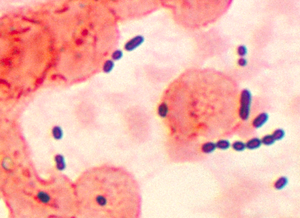Enterococci
| Enterococci | ||||||||||||
|---|---|---|---|---|---|---|---|---|---|---|---|---|

Enterococcus ( Gram stain ) |
||||||||||||
| Systematics | ||||||||||||
|
||||||||||||
| Scientific name | ||||||||||||
| Enterococcus | ||||||||||||
| (ex Thiercelin & Jouhaud 1903) Schleifer & Kilpper-Bälz 1984 |
||||||||||||
| species | ||||||||||||
Enterococci ( German plural from the Latinized singular Enterococcus , which is composed of the two ancient Greek components ἔντερον énteron 'intestine', 'entrails' and κόκκος kókkos 'core', 'grain') were originally classified as streptococci of Lancefield group D. but separated from the streptococci as a separate genus . Enterococci are ubiquitous in the environment (water, soil), in animals and humans (in the normal intestinal flora ) and in fermented foods such as cheese or raw sausages .
Microbiological properties
Enterococci are gram-positive , catalase- negative and, due to the lack of porphyrins and cytochromes, are classified as aerotolerant, anaerobic bacteria . The spherical ( coconut ) bacteria are arranged in pairs or short chains.
In humans and animals, of the approximately 25 known enterococcal species, two species, E. faecium and E. faecalis , play an important role in the digestive system . They are therefore also used in probiotic foods to promote the intestinal flora of the digestive system.
Enterococci in food play an important role in fermentation and ripening processes and contribute to the special and desired taste of the food (e.g. buffalo mozzarella , camembert and goat cheese).
Other species that can rarely occur in humans are E. durans and E. casseliflavus .
Properties as a pathogen
Certain strains of enterococci (especially certain E. faecalis strains) can cause infections in people whose immune systems are severely weakened .
Enterococci are mainly to be found as the cause of urinary tract infections, postoperative peritonitis , wound infections , bacteremia and sepsis as well as endocarditis . They are also causative agents of some serious nosocomial infections .
therapy
Amoxicillin and ampicillin are suitable for antibiotic therapy, provided there is no resistance to them. For Enterococcus faecalis, ampicillin with or without gentamicin , alternatively mezlocillin , piperacillin and vancomycin can be used. With Enterococcus faecium vancomycin, teicoplanin , daptomycin and alternatively linezolid or tigecycline . There is a natural resistance to cephalosporins , aminoglycosides and some penicillins ; these antibiotics are referred to as the “enterococcal gap” (Enterococcus faecium is usually ampicillin-resistant, while Enterococcus faecalis is ampicillin-sensitive. Tigecycline and linezolid are suitable for the treatment of VRE and (if sensitive) also fosfomycin .).
GRE / VRE
Enterococci that are resistant to the entire antibiotic group of glycopeptides or specifically to vancomycin belonging to this group are referred to as glycopeptide-resistant enterococci (GRE) or vancomycin-resistant enterococci (VRE).
Vancomycin-resistant enterococci (VRE) were first reported in 1988. Today, VREs are one of the most common causes of bacteremia in hospital patients after antibiotic treatment, especially in cancer patients after chemotherapy. Vancomycin resistance is most common in Enterococcus faecium . A common way of transferring resistance is the so-called horizontal gene transfer via the exchange of VanA or VanB gene clusters .
literature
- Constanze Wendt, Henning Rüden, Michael Edmond: Vancomycin-resistant enterococci. Epidemiology, Risk Factors, and Prevention. In: Deutsches Ärzteblatt . Cologne, vol. 95 (1998), issue 25, ISSN 0012-1207 , pp. A1604-A1611.
- Mathias Kolbert, Pramod M. Shah: Multi-resistant enterococci. Epidemiology, risk factors, treatment options. In: drug therapy. Vol. 17 (1999), issue 4, ISSN 0723-6913 , p. 133 ff.
- G. Schulze, W. Schott, G. Hildebrandt: Vancomycin-Resistant Enterococci. Hospital kitchen as a vector? In: Federal Health Gazette Health Research Health Protection . Vol. 44 (2001), No. 7, ISSN 0007-5914 , pp. 732-737.
- Arne Simon, Nora Gröger, Steffen Engelhart, Ernst Molitor, Martin Exner, Udo Bode, Gudrun Fleischhack: Vancomycin-resistant enterococci (VRE). Overview of importance, prevention and management in pediatrics. In: Hygiene and Medicine. Vol. 29 (2004), issue 7/8, ISSN 0172-3790 , p. 259 ff.
- Barbara Murray: Diversity among multidrug-resistant enterococci. In: Emerging Infectious Diseases . Vol. 4 (1998), pp. 37-47.
- Marianne Abele-Horn: Antimicrobial Therapy. Decision support for the treatment and prophylaxis of infectious diseases. With the collaboration of Werner Heinz, Hartwig Klinker, Johann Schurz and August Stich, 2nd, revised and expanded edition. Peter Wiehl, Marburg 2009, ISBN 978-3-927219-14-4 , p. 263.
Web links
Individual evidence
- ^ Wilhelm Gemoll , Karl Vretska : Greek-German school and hand dictionary . 10th edition. Oldenbourg, Munich 2010, ISBN 978-3-637-00234-0 .
- ^ Herbert Hof: Medical Microbiology. 3. Edition. Thieme, Stuttgart 2005, ISBN 3-13-125313-4 .
- ↑ Luc Devriese, Margo Baele and Patrick Butaye: The Genus Enterococcus . In: The Prokaryotes . Vol. 4. Springer US, New York 2006, ISBN 978-0-387-25494-4 , pp. 163-174.
- ↑ Herbert Hof, Rüdiger Dörries: Dual series of medical microbiology. 4th edition. Thieme, Stuttgart 2009, ISBN 978-3-13-125314-9 , p. 330.
- ↑ Marianne Abele-Horn (2009), p. 263.
- ^ Marianne Abele-Horn: Antimicrobial Therapy. Decision support for the treatment and prophylaxis of infectious diseases. With the collaboration of Werner Heinz, Hartwig Klinker, Johann Schurz and August Stich, 2nd, revised and expanded edition. Peter Wiehl, Marburg 2009, ISBN 978-3-927219-14-4 , p. 263.
- ^ Anne H. Uttley, C. Collins, Jay Naidoo, R. George: Vancomycin-resistant enterococci (letter). In: The Lancet . 1988, Vol. 331, No. 8575/8576, ISSN 0939-6217 , pp. 57-58.
- ↑ Carles Ubeda, Ying Taur, Robert R. Jenq and a .: Vancomycin-resistant Enterococcus domination of intestinal microbiota is enabled by antibiotic treatment in mice and precedes bloodstream invasion in humans. In: Journal of Clinical Investigation . 2010, Vol. 120, No. 12, ISSN 0021-9738 , doi : 10.1172 / JCI43918 , pp. 4332-4341.
- ^ W. Witte: Spread of multi-resistant pathogens. In: Trauma and Occupational Disease. May 2008, Vol. 10, No. 1 Supplement, pp. 125-132, doi : 10.1007 / s10039-007-1278-4 .